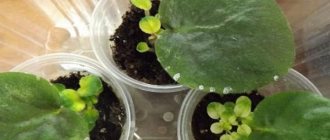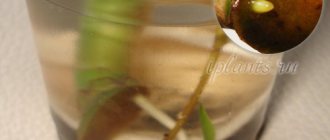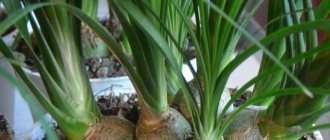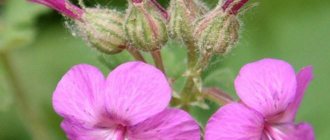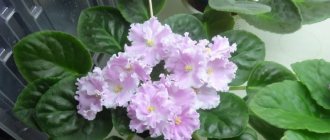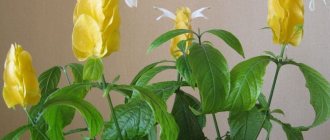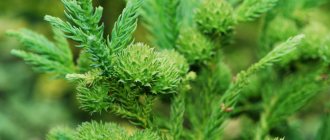The natural habitats of Washingtonia are subtropics. It was first discovered in the United States and northwestern Mexico. The Mediterranean climate is ideal for this plant, but it can tolerate frosts up to 12 degrees.
Washingtonia can otherwise be called a palm tree. It can reach 20-30 meters high. They classify it as an evergreen plant. The leaves are large, up to one and a half meters in size. There are remains of dry leaves on the trunk, with which it is covered. The area of the root neck may be in the adventitious roots. The Washingtonia leaf resembles a fan because it is dissected to the center. At the flowering stage, it forms a bisexual flower located on a peduncle 3 meters long. The inflorescence is a panicle, which when ripe produces black fruits.
Rules of care
- The lighting should be bright enough. A southern room, a veranda, a balcony - all this is suitable for a tropical miracle. While the plant is small, it needs constant supervision and care, and only when it becomes an adult can the tree grow in a place with less high light levels.
- You need to water the plant regularly, but take into account seasonality. In summer, when the weather is hot, the palm tree needs to be watered once a week. In winter, when it’s cold outside, watering should be reduced and done only when the soil is completely dry. During this period, the tree rests, but still should not be allowed to dry out. This will lead to the inevitable death of the palm tree.
- The air humidity in the room where the palm tree grows should be from 55 to 75 percent. To maintain such humidity, sprayers must be used. In winter, it is also practiced to wash the leaves with a damp cloth.
- As the tree grows, you need to rotate it in relation to the light source. This is necessary for the correct formation of foliage.
Sources
- https://sornyakov.net/komnatnye/vashingtoniya.html
- https://CvetnikInfo.ru/komnatnye-tsvety/palma-vashingtoniya.html
- https://fb.ru/article/259493/vashingtoniya-palma-vyiraschivanie-v-domashnih-usloviyah-foto
- https://flower-fan.ru/palma-vashingtoniya/
- https://dachadizain.ru/cvety/komnatnye/osobennosti-uxoda-za-palmoj-vashingtoniya.html
- https://www.glav-dacha.ru/ukhod-za-palmoy-vashingtoniey/
- https://tsvetydoma.ru/komnatnyie-rasteniya/palmyi/palma-vashingtoniya.html
- https://www.ocvetah.com/flowers/komnatnye/vashingtoniya.html
- https://chvetochki.ru/vashingtoniya/
Feeding palm plants: fertilizers and scheme
Palm plants require regular, but not excessive mineral feeding. The ratio of nitrogen, phosphorus and potassium in the formula of the selected fertilizer should be approximately equal. The following ready-made mineral compositions have proven themselves well:
| Fertilizer name | Composition and purpose | Preparation | Application |
| "Pokon for palm trees" | The proportion of nitrogen, phosphorus and potassium is 6:6:5. Fertilizer works well in the first half of the season, helping to form beautiful and healthy young leaves. | Dilute 5 ml of concentrate in 1 liter of water | Use after watering, at the root, once a week. |
| “Good power for palm trees, dracaenas, zamioculcas” | The proportion of nitrogen, phosphorus and potassium is 4:4:3. The composition is enriched with humic acids, vitamins B1 and PP, and succinic acid. Designed for year-round feeding. | For root feeding – dilute ¼ cap of concentrate in 2 liters of water. To feed the leaves, dilute ¼ cap in 4 liters of water. | Root feeding by watering - once a week from spring to autumn. In winter - once a month. Foliar feeding by spraying on the leaves - according to the same scheme. |
| "Bona Forte for ficus and palm trees" | The proportion of nitrogen, phosphorus and potassium is 6:4:5. The composition includes magnesium, chelated microelements, vitamins C, B1 and PP, and succinic acid. Designed for feeding from spring to mid-summer. | Dilute 10 ml in 1.5 liters of water. | Fertilize after watering once a week at the root. |
When the palm tree begins to actively grow young leaves, it is useful to give it root feeding with a glucose solution. To do this, the pharmaceutical ampoule preparation is dissolved in irrigation water at the rate of 1 ampoule per 1 liter.
The larger the plant, the higher the fertilizer consumption. Typically, for each liter of soil, add 0.2 liters of the prepared working solution.
How to grow an evergreen giant from seeds?
Washingtonia from seeds is the only way to propagate this plant, since the palm tree does not produce side shoots.
For planting, select a container commensurate with the size of the tree. A small flower cannot be planted in a huge pot. When planting, you should follow several rules:
- 1Seeds should only be fresh, since the duration of their storage directly affects their germination.
- 2 Seed substrate, which consists of: leaf soil, peat, sand (2: 0.5: 0.5). Or moss, sawdust, sand in a ratio of 1:1:1.
- 3Before sowing seeds into the soil, you can use the growth stimulator Epin, in which you need to soak the seeds for 12 hours.
- 4Scarification - cutting the seeds with a very sharp knife (or rubbing with sandpaper). Place each seed in water for a period of 2 to 7 days.
- 5Place the seeds in the soil in a pot or tray, sprinkle on top to a thickness that is twice the diameter of the seeds.
- 6It should be warm enough from +25 to +30°C.
- 7Cover the pot or tray with film or glass to create a greenhouse effect.
- 8Ventilate and moisten regularly.
After 2-3 months, seedlings should emerge. When this happens, the tray with seedlings needs to be moved to a sufficiently lit place that is not exposed to direct sunlight. Plant seedlings of indoor Washingtonia when 2 leaves appear. Soil in pots for diving should be chosen for palm crops. It is best to start cultivating evergreen Washingtonia seeds in the spring. The seedlings grow very quickly, but the first fan leaves appear only after a year.
Interesting Facts
- The palm tree is a symbol of victory, so in ancient times a palm branch was awarded to the winners.
- Colombia and the island of Madagascar hold the record for the number of palm trees growing on their territory.
- In tropical countries, the plant is cultivated as an agricultural crop.
- In dry weather, tree growth occurs only at night.
- Their natural habitat is tropical and subtropical climatic latitudes.
- In the 60s of the last century, archaeologists discovered a pot with palm seeds. Their age was more than 2 thousand years. In the 21st century, scientists tried to grow a tree from them. The attempt was successful, and one of the found seeds sprouted.
Diseases and pests
Despite the fact that the palm tree is a fairly hardened plant, it can still be susceptible to fungal diseases and attacks by various pests. As for the first point, here you will need to carry out proper watering. This is the only way to avoid diseases. Among the pests it is worth noting the following.
- Mealybug. It is a small insect that feeds exclusively on plant juices.
- Spider mite. Experienced gardeners consider it a very serious pest, despite its small size. It also feeds on the sap of the plant, while entangling the leaves with a web.
- Whitefly. This is a rather dangerous polyphagous insect that can be seen even with the naked eye. With its appearance, the leaves turn yellow and then completely fall off.
It is best to combat any of these insects with the help of special chemicals that can be purchased at any special institution. All doses are usually indicated on the packaging. But if they are not there, you can always ask the seller for help. Anyone who prefers to use only folk remedies in pest control can try wiping the leaves with a swab dipped in a solution of laundry soap. However, this approach will only help for preventive purposes.
For information on how to properly replant a palm tree, see below.
How to take care of palm spear
The spear is the point where new growth occurs in the palm tree. This is the most vulnerable part of the plant. If it has rotted, this could have a number of reasons.
If you apply fertilizer, make sure it is applied to the soil around the plant and not on the spear.
If mold or bacterial infection appears, it usually does not kill the plant. There are many special sprays for treating plants against bacteria.
If the plant is too wet and then exposed to very cold conditions, it can harm the palm tree.
Leaves often turn brown during warm periods after a cold winter. This is a sign that the leaves have not been cared for correctly. Prevention is better than any cure! If this happens, don’t be too upset, new leaves grow every year.
Growing indoor Washingtonia palm tree from seeds
To get an elegant fan-shaped beauty from a seed, you need:
- Fresh seed. You can buy it, or you can assemble it yourself.
- Mandatory scarification. An incision is made on the seeds with a very sharp knife and they are kept in water for two to seven days.
- Substrate for seeds. For it, take leaf soil, sand and peat in a ratio of 4:1:1.
It is optimal to begin the process of growing indoor Washingtonia in the spring. The prepared composition is poured into a tray, the seeds are laid out and sprinkled with the same substrate to a height twice the diameter of the seed. Then the container is covered with glass or polyethylene to create a greenhouse effect, and try to ensure a temperature regime of 25-30°C. Crops are regularly opened for watering and ventilation.
Within two to three months, the first seedlings should hatch. When this happens, the tray with seedlings is transferred to a well-lit place where there is no direct sunlight. After the second leaf appears, Washingtonia seedlings are planted in separate pots. The substrate is taken special for palm plants.
Note! Picking must be done very carefully so that the roots remain intact and the integrity of the endosperm is not compromised. You can grow a fan palm from seeds in other ways, which differ from the above in some nuances.
You can grow a fan palm from seeds in other ways, which differ from those described above in some nuances.
- When germinating seed, you can use peat tablets. One seed is placed on them and transferred to the ground. The top layer of the substrate is poured after the seedlings are noticeable.
- You can also germinate seeds in a different soil composition - you need to take sand, moss and sawdust in equal parts.
- First, before sowing the material both in the soil and in peat tablets, stimulate growth with the drug “Epin”. You need to soak the seeds in it for 10-12 hours.
Plant propagation
Washingtonia can be grown from seeds. For this you need fresh seeds; old ones will not sprout. Seeds need to be stratified. An incision is made on the seed and it is immersed in water for one week.
It will be interesting to read about the cultivation of Achimenes.
Seeds are planted in early spring. The soil mixture for seeds should consist of leaf soil, peat soil and sand. Leaf soil is taken 4 times more. Stratified seeds are placed on moist soil.
Cover with the same soil to a height that is twice the thickness of the seed. Glass or film is placed on top. Seeds should be kept in a room with a temperature of 26-30 degrees. Every day you need to ventilate the seeds and water them if necessary.
Seedlings will appear in two or three months. Then the cover is removed and the container with the sprouts is placed in place with diffused lighting. When the third leaf appears, the sprouts are planted in separate containers.
They dive using the transshipment method. The sprouts are removed from the soil along with the soil clod. This will ensure quick adaptation of the seedling to a new location.
You can use peat tablets. Place a seed on each one and place it on the soil. When barely noticeable sprouts appear, cover the top with soil. Another option for soil: take sphagnum moss, sand and sawdust in equal proportions. To stimulate growth, seeds are sometimes soaked in Epin for ten hours.
Diseases, pests and possible problems
When growing such a beauty, you need to know the peculiarities of its maintenance. It will be a great pity when the plant sheds its leaves or dies altogether.
- When there is not enough moisture in the soil or not enough potassium, you can tell by the blackened edges of the leaves. This can be corrected by timely watering and fertilizing with microelements potassium and phosphorus.
- When the leaves become dark in the middle, this indicates a lack of moisture. This means the air in the room is dry for the plant. It is necessary to spray with warm water more often. You can pour some water into the pan and lay out pebbles or moss.
- If the leaves are spotted, on the contrary, there is a lot of water in the soil.
- Stop watering temporarily and observe the plant.
- Leaves should fall periodically, this is a natural process. If they begin to fall sharply, then this is already a problem. Falling may occur when the roots rot due to waterlogging.
- Scale insects or scale insects may appear on the leaves. Then the leaves will begin to curl and become sticky. Spraying with insecticides is used.
It is not difficult to maintain a Washingtonia palm tree if all requirements are met. Take care, and the plant will thank you with beautiful fan leaves.
Description
Washingtonia lives in the subtropical zone, with a suitable Mediterranean climate. Therefore, it is found naturally in the southwestern United States and northwestern Mexico. Botanists know two varieties of Washingtonia
These species can grow in North Africa and southern European countries. When kept at home, it requires special attention. But caring for the palm tree will return beautiful fan-shaped leaves that will decorate any room. The palm tree can grow up to thirty meters in height
Its trunk reaches one and a half meters in girth. The leaves are very large, fan-shaped, and can grow up to 150 cm in length. The green leaf is cut to the center of the leaf. The trunk may be in knots if there are remains of leaves. Or it can be smooth if all the foliage along with the bare petioles has fallen off. Palm flowers are formed in a spikelet and are located on a long flowering stem. The flowers on the plant are bisexual and, after pollination, form dark brown fruits. The palm seeds are edible; the Indians living there eat them. In addition to people, birds eat the seeds. At home, Washingtonia practically does not bloom. Usually it can form a flower-bearing arrow once in 4-6 years.
Types and varieties of Washingtonia
Two types of indoor Washingtonia are cultivated:
California filamentous Washingtonia
In nature it forms a palm forest. The leaves have a gray-green color with a yellow rim along the edges and white thin threads. The palm tree grows up to 20 meters and in diameter up to six meters. Dying leaves do not fall off, but form a skirt of leaf debris.
Small birds or invertebrate fauna like to live in such nests. When kept indoors in winter, the palm tree needs a temperature no higher than 15 degrees and natural light.
Mexican robusta palm
It can grow into a thirty-meter beauty with huge fan-shaped leaves of bright green color. All leaves are at the very top. Each meter-long petiole is protected by small thorns. The inflorescence reaches three meters in length and bears many orange and pink flowers. The resulting fruits are blue-black drupes. In indoor conditions, there is no need to lower the temperature in winter.
Types with descriptions and photos
There are only two types of this plant - Washingtonia stout and Washingtonia filamentosa.
Thread-bearing or filamentous (Washingtonia filifera)
In its homeland, Washingtonia filamentosa grows up to 20 meters . It has a straight, even trunk. The fan-shaped leaves have a grayish-green tint and green petioles. The leaves form many white threads, which is how the palm tree got its name.
Robust (Washingtonia robusta)
Under natural conditions, the height of the palm tree reaches 30 meters. The trunk is thinner and elongated. The leaves are rich green, without white threads. Leaf petioles are brown.
Home care for palm trees
Lighting and location
The best location for Washingtonia is windows on the east or west side. The palm tree requires good lighting, but the rays should not be direct, but should be evenly dispersed. In the hot summer season, it is better to move the palm tree to a darker place.
Temperature
In spring and summer, the palm tree is most comfortable at a temperature of 20-24°C.
If the temperature is still above thirty degrees, then Washingtonia must be moved to a cool place. This plant can exist at sub-zero temperatures, so in winter it needs 7-10°C.
Watering
Washingtonia needs to be watered with lukewarm water. In summer, the palm tree needs to be watered as soon as the top layer of soil is dry. But do not overdo it, the plant does not tolerate high moisture, as well as dry soil. In winter, the palm tree needs to be watered 2-3 days after the top of the soil has dried.
Air humidity
For indoor Washingtonia, air humidity is very significant. The plant loves it when it is sprayed and the leaves are wiped with a soft damp cloth.
Feeding and fertilizers
The rest of the time, Washington does not require this. It is possible to fertilize the soil with different group compositions, which include a huge amount of iron. They must be administered twice a month.
Trimming
Washingtonia pruning is done in order to stop the leaves from drying out. However, this process is not considered integral in any way, since dried and drooping leaves do not in any way worsen the appearance of the palm tree. If you decide to prune, this must be done before the entire leaf turns yellow.
Transfer
Before replanting the plant, you should organize the foundation. It should be combined with turf, deciduous leaves, sand and humus in a ratio of 2:2:2:1. Transshipment is carried out with special frequency. If the palm tree is younger than 7 years old, it must be replanted once every 2 years, if it is older than 7 years - every 3 years, if Washingtonia is older than 15 years old, it must be replanted once every 5 years. When transshipping, the base of older palm trees is fed with up to 5 kilograms of organic matter, and if, as the palm tree grows, the roots begin to protrude from the pot, they need to be covered with earth.
Planting and transplanting
Initially, for a fairly large palm tree, you need to choose a spacious and tall pot in which the root system will develop well. The substrate must be loose, moisture- and breathable, and also contain the necessary nutrients. For planting, you can purchase a ready-made substrate for palm trees or create a soil mixture yourself from turf, humus, leaf soil and sand in proportions 2:2:2:1.
The tree can be replanted at the end of February, or better yet, in early spring. This must be done very carefully using the transfer method, preserving the earthen lump and trying not to damage the roots.
Young plants are replanted with soil renewal every year, 5-year-old palm trees - no more than once every 3-5 years, and mature 10-year-old trees only in case of urgent need, since they do not like to be disturbed. At the same time, in a pot of adult specimens it is necessary to periodically update the top layer of the substrate.
Advice! To speed up germination and increase the percentage of germination, it is recommended to scarify the seeds, that is, artificially break the integrity of the shell with sandpaper or a sharp knife.
Washingtonia filamentous or filamentous (Washingtonia filifera)
There are only two species in the genus, which are not very different from each other. Both representatives can be grown indoors if you know what their most important difference is - the temperature regime. First of all, let's talk about a more cold-resistant species, Washingtonia filamentosa; it is a perennial palm tree up to 25 meters high. The trunk has a cylindrical shape. Its diameter is up to 80 cm. The gray surface is covered with interspersed leaf petioles, which is why it can have a ribbed structure.
Towards the top, the trunk of filamentous Washingtonia gradually narrows and bears a rosette of fan-shaped leaf plates. The leaves of the plant reach 3-4 meters. The leaf blade is pinnately dissected into 70-90 pieces. The middle part is represented by xiphoid segments, up to 1.5 meters long and up to 6 cm wide. The extreme part is smaller in length (up to 80 cm) and width (up to 1 cm). The entire leaf blade has white threads that hang along the edges of the fan leaves.
The leaves of Washingtonia filifera are attached to the trunk by large woody petioles. On their lower surface there are sharp, spine-like teeth of a yellowish color with a bent tip towards the shoot of the palm tree. During the period of active growth, which lasts from early May to autumn, up to 13 leaves are formed, which have a lifespan of 2-4 years.
The flowers of filamentous Washingtonia are collected in long paniculate inflorescences, reaching from 3 to 5-6 meters in length. They are bent in an arc towards the surface of the trunk. After flowering, fruits are formed - oblong drupes with a fleshy surface and seeds.
3.Varieties:
3.1.Washingtonia filifera
Slender, elegant palm trees up to 15 m high. The tree trunks are thick, powerful, and carry the remains of old, fallen leaves. The leaves are compound, fan-shaped, reaching a length of 4 m. The petioles of the leaves grow up to 2 m, and in adult plants they have curved spines. The leaf segments are glossy, dark green, reaching a length of 100 - 120 cm. A distinctive feature of this plant is the presence of thin light fibers on the leaves. In its natural environment, during the warm season, the plant forms large, penetrating inflorescences with small, yellowish flowers. After flowering, the flowers turn into small round berries with a diameter of up to 1 cm. In indoor culture, flowering rarely occurs.
3.2.Washingtonia robusta or powerful - Washingtonia robusta
Tall slender palm trees reaching 30 m in height. The trunks are single, gray, with remnants of fallen leaves. In the natural habitat, dried leaf blades often remain under the lush green crown. The leaves are complex, fan-shaped, reach one and a half meters in diameter, and consist of numerous narrow, linear, glossy segments. The leaf petioles grow up to 1 m in length and have sharp spines along the edge. Large, branched, drooping inflorescences grow up to 3 m and bear numerous small orange or yellow flowers. As the flowers ripen, they turn into round black berries up to 8 mm in diameter.
You might also be interested in:
Planting a Washingtonia Palm
The plant is cultivated as an ornamental foliage plant.
The crop requires very good illumination, the light must have such a characteristic as diffuseness, this is absolutely necessary. Daylight should last for approximately 16 hours. During the winter season, Washingtonia needs to be illuminated with additional light sources.
In spring and summer, the plant requires temperature conditions within 20-24 degrees, no more, in the winter season - about 10 degrees.
In spring and summer, the soil mixture in the container is moistened after the surface soil layer has dried. In cold weather, watering is applied in a small volume and rarely, but it is unacceptable that the soil ball dries out.
Air humidity should be high. During the growing season, Washingtonia leaves are moistened 2 times/24 hours, in addition, the leaves are washed once a week with a wet sponge. In order to increase the level of air humidity, open containers filled with water are placed near the tree. During the winter season, wetting the palm tree is prohibited.
It is necessary to apply fertilizers from spring to autumn 1 time/15 days; fertilizing should contain a large amount of iron. In winter, fertilizers are not applied.
The dormant period begins late in the fall, and ends at the beginning of the spring season.
In the spring, the Washingtonia palm tree is replanted if really necessary. Up to 7 years, the plant is replanted once every couple of years, up to 15 years - 1 time/three years, adult Washingtonia is replanted once/4-5 years.
The soil mixture contains peat (or humus), sand, leaf and turf soil for the Washingtonia palm tree, in a proportional ratio of 2:1:2:4, respectively.
The houseplant Washingtonia is cultivated by seed.
Pests that can threaten with their attacks: scale insects, whiteflies, spider mites, mealybugs.
Diseases. Rot can affect the root system of the Washingtonia palm tree due to improper watering rules or a lack of drainage layer in the container. Drying of the tips of Washingtonia leaves may occur due to the dry air at home.
Useful video
Visually familiarize yourself with the features of growing Washingtonia palm trees at home:
Having familiarized yourself with the above materials, you can now make the only right decision for yourself - whether you want to grow or install a Washingtonia palm tree yourself.
Are you ready for some of the difficulties associated with growing and caring for this palm tree? At the same time, remember that such a luxurious plant will completely transform your life and radically change the interior of the room, making it non-standard, “subtropical”.
Types of indoor palm trees
Palm trees have been used to decorate interiors in our country for a long time, since the beginning of the 19th century. Of the entire variety of natural species, about 20 are common in indoor floriculture. Depending on the size and shape of the leaves, several groups are distinguished.
Reed
Reed palm
This group of plants has thin stems reminiscent of bamboo shoots with a height of 1 m or more. They are suitable for spacious rooms.
Chamaedorea Seifrizii and Chamaedorea Erumpens have dark green leaves, only the former has narrow leaves, and the latter has wide leaves. Their height can reach 2–3 m.
Cirrus
Palma pinnata
The fronds of plants in this group are divided into leaves, which can be soft and arched or hard and straight.
Fan
fan palm
The large leaves are shaped like segments, fanning out from the base of the leaf blade. The petioles are long, with spines.
Canary date (Phoenix canariensis)
Date canarian
Popular view. It is often offered in garden stores and centers. Growing up, it turns into a large plant with narrow, hard and straight leaves. Unpretentious, he only needs sunlight from the window.
Date Robelena
Does not grow above 2 meters. The lush crown with curved narrow leaves looks very beautiful.
Chamaedorea elegans (Chamaedorea elegans)
Hamedorea gracilis
One of the most common compact types. It is loved by flower growers because it is perfectly adapted to pot growing in small spaces, although in its native Mexico it grows in humid forests. It grows very slowly, reaching only 60 cm in a few years. In good light, yellow flowers appear in adult specimens and fruits are set.
Howea
Hovea
Varieties of this palm tree are shade-tolerant and resistant to pests. Does not lose its decorative effect in dry indoor air. A suitable plant for novice gardeners who want to grow an exotic southern plant for the first time.
Livistona Chinese
Slow growing palm. It is distinguished by large leaves with drooping tips.
Washingtonia filifera
Washingtonia filamentosa
Originally from North America. It can be immediately recognized by the fibers on the edges of the leaves, which in appearance resemble a beard.
Rapis
Rapis tall
An unpretentious Asian palm, drought-resistant. Several species are grown at home: tall rapeseed (Rhapis excelsa), multi-cut rapeseed (Rhapis multifida), as well as popular varieties of tall rapeseed with variegated foliage.
Fishtail Palms (Caryota)
Kariota
Forms graceful low bunches of stems. Green leaves of unusual shape, up to 15 cm long and up to 10 cm wide. They look impressive and are easy to care for.
Pandanus care at home
It is not at all difficult to care for the plant. This unpretentious indoor palm tree does not make any special demands on its existence. For successful maintenance, it is advisable to consider some of the subtleties of its care.
Selecting a location and temperature
The Pandan plant thrives throughout the year in bright light. It is better to place indoor pandanus near windows from the west or east. It is advisable to rotate the pot with the plant periodically to prevent it from being one-sided.
Important! Lack of lighting will negatively affect the brightness of foliage color. Temperature ranges from 19˚С to 25˚С will be acceptable for indoor palm trees all year round.
Temperature ranges from 19˚С to 25˚С will be acceptable for indoor palm trees all year round.
Remember! During the cold period, the temperature in the room should not be lower than 13˚C. This temperature limit leads to the death of pandan.
Pandanus has a love of fresh air. So periodic airing will be pleasant for the flower.
Main! Protect your indoor plant from drafts.
Humidity and watering
The pandanus palm can be content with moderate environmental humidity levels. You can wipe the leaves from bottom to top with a damp cloth. Be sure to use gloves. There is no need to get rid of the aerial roots that have appeared; add some moss to the flowerpot and keep it moist. For greater comfort, you can use flower pots with automatic watering.
Summer watering should be plentiful at intervals of 3 days. It is necessary that the upper part of the earthen mixture dry out slightly between waterings. We use slightly lukewarm and settled water. In the cold off-season, we reduce watering and be sure to monitor the condition of the substrate.
Soil mixture and its fertilizer
Turf and leaf soil, sand and humus are a suitable and comfortable soil mixture (equal parts).
This flower needs systematic feeding in the off-season. It is better to use a complex mineral fertilizer, which is suitable for all decorative foliage plants.
How to propagate pandanus?
Using seeds, separated bushes and cuttings.
Seeds are sown in a sand-peat mixture and stored in a mini-greenhouse at a temperature of +25 °C. It is advisable to look occasionally and moisten the earthen mixture. In a month the shoots will appear. It is better to plant seedlings with three leaves in a stable place.
The cut lateral twenty-centimeter cuttings are slightly dried, having previously treated the cuts with charcoal. They are rooted in a soil mixture of equal parts sand and peat. We organize greenhouse conditions with temperatures of 25-28˚C. We systematically ventilate and water with a spray bottle; within one and a half to two months the sprouts acquire roots.
Daughter rosettes formed on the trunk or leaf axils are also suitable for propagation of the screw palm. We separate the rosettes with small roots and plant them in flat flowerpots. Good drainage of at least twenty millimeters is required, then turf soil of at least seventy millimeters and sand, a layer of at least forty millimeters. We plant the roots in the sand, press them, cover them with translucent hermetic material and create a comfortable temperature of more than 22 degrees. After 2 months, the matured cubs are transplanted into larger pots.
Transfer
The screw tree has rather fragile roots. Therefore, replanting must be done very carefully, transferring from a small pot to a larger one. Every year you can renew the flowerpot for young specimens, and for older palm trees you can increase the period to three years by filling the flowerpot with roots.
Pandanus pests and diseases
Occasionally, the plant is attacked by uninvited guests: scale insects, spider mites, and scale insects. If pests are identified, treat the plant with an insecticide. However, in general, the indoor pandanus palm is not very attractive to pests.
Difficult moments of growing
- Pandanus leaves turn yellow - the earthen mixture is oversaturated with calcium; hard water is used for irrigation; lighting is too bright.
- The foliage is too small and the variegated saturation of its color fades - the palm tree does not have enough light.
- The ends of the leaves dry out and turn brown - low air humidity.
Carefully read the interesting aspects of growing indoor pandanus, love it, take care of it, and this miracle palm tree will decorate both your home and office space.
You can get acquainted with other interesting indoor flowers by opening the catalog of indoor plants on the website.
Preparing soil and seeds for growing Washingtonia
To obtain Washingtonia filamentosa or Robusta from seeds, you need to prepare a special soil by mixing one part of leaf soil and perlite or sand. You can also use a mixture that contains moss, sand and sawdust in equal parts, which are pre-steamed.
You can add a little crushed charcoal to the prepared soil. Before planting, the soil is sterilized and the seedling boxes are disinfected.
If you want to get a Washingtonia palm tree from fresh seeds, you can immediately sow it in the ground. If the seed material is more than a year old, then they need to be lightly sanded to speed up germination.
Then you need to soak in warm water (up to 40 degrees) for two days. You can add a growth stimulator to the water.
